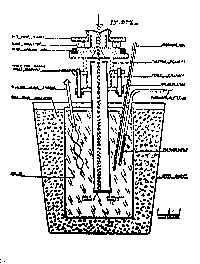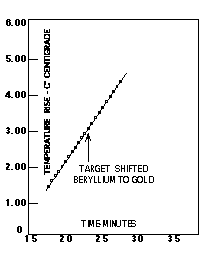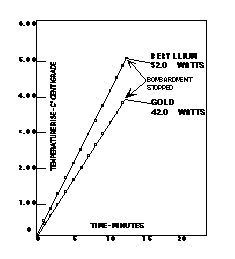RELATED PUBLICATION: Calorimetric Experiment
Physical Review Volume 70, Numbers 3 and 4 August 1 and 15, 1946
Calorimetric Experiment on the Radiation Losses of 2-MeV Electrons [1]
W. W. Buechner and R. J. Van de Graaff
Massachusetts Institute of Technology Cambridge, Massachusetts
(Received May 21, 1946)
Abstract
Various investigators report from cloud-chamber experiments that the energy lost in the scattering of 2-Mev beta rays is several times the loss calculated from the Bethe-Heitler theory. However, other experimenters have found that the production of x-rays in this range agrees with theory. To account for the extra energy loss, Klarmann and Bothe and Champion have suggested the emission of neutrinos as well as x-rays. To test this hypothesis, a 2-Mev beam of electrons was directed on a target immersed in mercury, the assembly acting as a calorimeter. Experiments using beryllium, gold, and mercury targets show that within the experimental error, which is somewhat less than one percent, no energy is carried out of the calorimeter by neutrinos or other penetrating radiation. It thus appears that the production of such radiations cannot account for the large extra energy losses reported from cloud-chamber experiments.
INTRODUCTION
A considerable number of researches with cloud chambers have reported that the energy lost in the scattering of beta-rays by heavy nuclei is several times the radiation loss calculated from the well-established Bethe-Heitler theory. For example, Klarmann and Bothe[2] report that in the energy range from 0.5 to 2.4 Mev the inelastic scattering in krypton and xenon is 2 to 5 times that predicted by the theory. Leprince-Ringuet[3] found indications of 10 times the expected mount for argon in the range 1 to 3 Mev and Laslett and Hurst[4] observed that, for lead, the scattering is high by a factor of 30 for energies from 1.5 to 4.5 Mew. Barber and Champion[5] found 6 times too much inelastic scattering for 1-Mev electrons scattered by mercury. It does not appear that theses excess energy losses can be due to the production of x-rays as Arcimovic and Chramov[6] and Petrauskas, Van Atta, and Myers[7] have found experimentally that the production of x-rays in this energy range is in agreement with the theory.
To account for the large extra energy losses, which have been reported, Klarmann and Bothe, and Champion[8] have suggested the emission of neutrinos as well as x-rays resulting from the interaction of fast electrons with heavy nuclei. In the case of the continuous beta-ray spectrum, calorimeter experiments performed by Ellis and Wooster[9] and by Meitner and Orthmann[10] have been employed to investigate the energy losses due to neutrino emission. The purpose of the calorimeter experiment described here was to determine whether or not the large energy losses referred to above could be accounted for by the emission of neutrinos or other extremely penetrating radiation.[11]
EXPERIMENTAL PROCEDURE
Figure 1 is a schematic drawing of a calorimetric apparatus constructed to investigate the possibility of such loss by high speed electrons. A 2-Mev electron beam from an electrostatic generator[12] passes downward into a copper tube provided with two targets at the bottom, one of beryllium and the other of gold. This tube was thermally insulated from the rest of the apparatus by the Micarta studs and Pyrex cylinder shown, and was arranged with a flexible metal bellows so that it could be tipped about a horizontal axis through the center of the diaphragm at the top of the copper tube. Thus the target holder could be shifted slightly by pulling a cord from a well-shielded remote control station, so that either target could be bombarded at will. This insulated target assembly was immersed in 42 kilograms of mercury, held in a container which was thermally insulated from the surroundings. The temperature of the mercury could be measured either with the thermocouple or with a Beckman differential thermometer viewed through a telescope. The thermometer proved to be the most convenient since it was direct reading and temperature differences could be readily estimated to 0.001 degrees C. A stirring rod was used to assure temperature equilibrium throughout the mass of mercury. The temperature rise due to the rotation of stirring rod was small and reproducible.
 Fig. 1. Schematic drawing of calorimeter
Fig. 1. Schematic drawing of calorimeter
There are two alternative methods by which such an apparatus can be used to investigate the possible production of extremely penetrating radiation by the impact of high speed electrons on nuclei. In the first place, the rate of heating in the calorimeter should decrease when the target is shifted from beryllium to gold in the middle of a single run, assuming, as has been suggested, an appreciable amount of energy is carried away by penetrating neutrinos when heavy nuclei are bombarded. It is to be expected, both from the experimental evidence and from general considerations, that energy loss due to neutrinos should be small or non-existent for a light element such a beryllium.
On the other hand, a calorimeter can be used in a more absolute way by calibrating it so that the temperature rise per second is known for any given power input at the target Then, if the voltage and the current of the beam striking the target are known, it is possible, by comparing the observed temperature rise with that to be expected from the power input, to determine whether any appreciable fraction of this incident energy is carried away by particles or radiations which are able to escape through the mercury of the calorimeter.
RESULTS
Figure 2 is representative of a number of measurements taken in the way discussed first in the previous section. For his curve the electron energy was 2 Mev, which is in the general energy range for which the cloud-chamber measurements indicate the greatest discrepancy with theory. Since the electron energy was reduced from 2 Mev to zero in the solid targets used, it is evident that the experiment also affords a check on radiation losses at voltages less than the maximum. The temperature rise in the mercury is plotted as a function of time with a steady electron beam of about 10 micro-amperes. At the time indicated by the arrow, the target holder was shifted so that the element under bombardment was changed from beryllium to gold. There is no perceptible change of slope as there would be if more energy escaped from the calorimeter from one target than the other. This shows that, if there is a difference in the amount of very penetrating radiation produced for heavy elements such as gold as compared to a very light element such as beryllium, it amounts to less than 1 percent of the incident energy. At 2 Mev, this is less than one-fifth of the energy loss to be expected from bremsstrahlung.

Fig. 2 Calorimeter run at 2 Mev. At the time indicated by the arrow, the target was shifted from beryllium to gold.(NOTE: For clarity of display, the above graph was reproduced to reflect the original diagram as faithful as possible).
Figure 3 shows two curves, representative of a number taken by use of the second method described above, the voltage again being 2 Mev. The power inputs indicated on the two curves are those computed from the voltage and the target currents. When correction is made for the small heat losses from the calorimeter, the temperature rise per watt of bombarding energy is the same for two targets within the experimental error. This temperature rise per watt also agrees, within the experiment error, with that obtained by a calibration run where the power input was obtained from the I2R heating of a resistor suitable located in the mercury in place of the target.

Fig. 3 Two calorimeter runs, both at 2 Mev. For beryllium the current was 26 ua; for gold 21 ua.(NOTE: For clarity of display, the above graph was reproduced to reflect the original diagram as faithful as possible).
DISCUSSION
Experiments on the production of x-rays previously referred to[6,7] show that, in the case of a heavy element like gold, of the order of 5 percent of the bombarding energy is transformed into x-radiation at 2 Mev, in agreement with the predictions of the Bethe-Heitler theory. Cloud-chamber experiments have indicated that the energy losses for the heavy elements are several times those predicted by this theory. If, for completeness, we assume that the observed cloud-chamber losses are 5 times the bremsstrahlung losses, then about 20 percent of the incident bombarding energy should escape from the calorimeter if the excess losses are to be accounted for by the production of neutrinos. Measurements on the absorption coefficient of 2-Mev x-rays show that only a negligible fraction of the x-rays produced can escape from the calorimeter through the mercury. Because of the small solid angle at the top of the target tube and the predominantly forward direction of the radiation, and even smaller fraction of the x-rays produced will escape upward. Thus, within the experimental accuracy, which is somewhat better than 1 percent, the present calorimeter experiments show that none of the energy of the bombarding electrons is transformed into extremely penetrating radiation which escapes from the calorimeter.
In the work described above, gold was used as a representative heavy element because of its convenient properties. In order to make observation with an element used in a cloud-chamber work, experiments were done with mercury as a target material. Barber and Champion have found about 6 times too much inelastic scattering for mercury. For this purpose, the target holder shown in Fig. 1 was altered and the gold replaced by a thin steel window 0.003 inch thick which allowed the electron beam to bombard the mercury in the calorimeter, the voltage in this case being raised to 2.3 Mev to compensate for the energy lost in the window. As in the case of gold, it was observed that within the experimental error there was no energy carried away by penetrating radiation.
It thus appears that the large energy losses which have been previously reported cannot be accounted for by the suggested emission of the neutrinos or other extremely penetrating radiation. A has been referred to in a previous footnote, this result is in accord with the experiment of Ivanov, Walter, Sinelnikov, Taranov, and Abramovich[11] who, employing lead and aluminum targets and a different calorimeter arrangement, find no evidence of neutrino emission and that the radiation losses of electrons in the general energy range are adequately accounted for by the Bethe-Heitler theory.
ACKNOWLEDGMENTS
We are glad to acknowledge the able assistance of Mr. Anthony Sperduto and Mr. E. A. Burrill in making the measurements, and of Mr. E. W. Nickerson in the construction of the apparatus. This work was supported in part by grants from the Research Corporation and the Carnegie Corporation of New York, to whom grateful acknowledgment is made.
FOOTNOTES
- A preliminary account of this work was presented at the February 1941 meeting of the American Physical Society, Phys. Rev. 59, 687 (1941)
- H. Klarmann and W. Bothe, Zeits. F. Physik 101, 489 (1936)
- L. Leprince-Ringuet, Ann. de physique 7, 5 (1937)
- L. G. Laslett and D. G. Hurst, Phys. Rev. 52, 1035 (1937)
- A. Barber and F. C. Champion, Proc. Row. Soc. A168, 159 (1938)
- L. A. Arcimovic and V. A. Chramov, Comptes Rendus. Acad. Sci, U.S.S.R. 7, 415 (1938)
- Petrauskas, Van Atta, and Myers, Phys. Rev. 63, 389 (1943)
- F. C. Champion, Rep. Progress Phys. 5, 348 (1938)
- C. D. Ellis and B. A. Wooster, Proc. Roy. Soc. A117. 109 (1927)
- L. Meitner and W. Orthmann, Zeits. f. Physik 60, 143 (1930)
- Since the experimental work here reported was completed, we have seen the paper of Ivanov, Walter, Sinelnikov, Taranov, and Abramovich, J. Phys. U.S.S.R. 4, 319 (1941). These authors describe a somewhat different calorimetric experiment on the radiation losses of fast electrons incident on lead and aluminum. The results of the two experiments are consistent.
- Van Atta, Northrup, Van de Graaff, and Van Atta, Rev. Sci. INST. 12, 534 (1941)